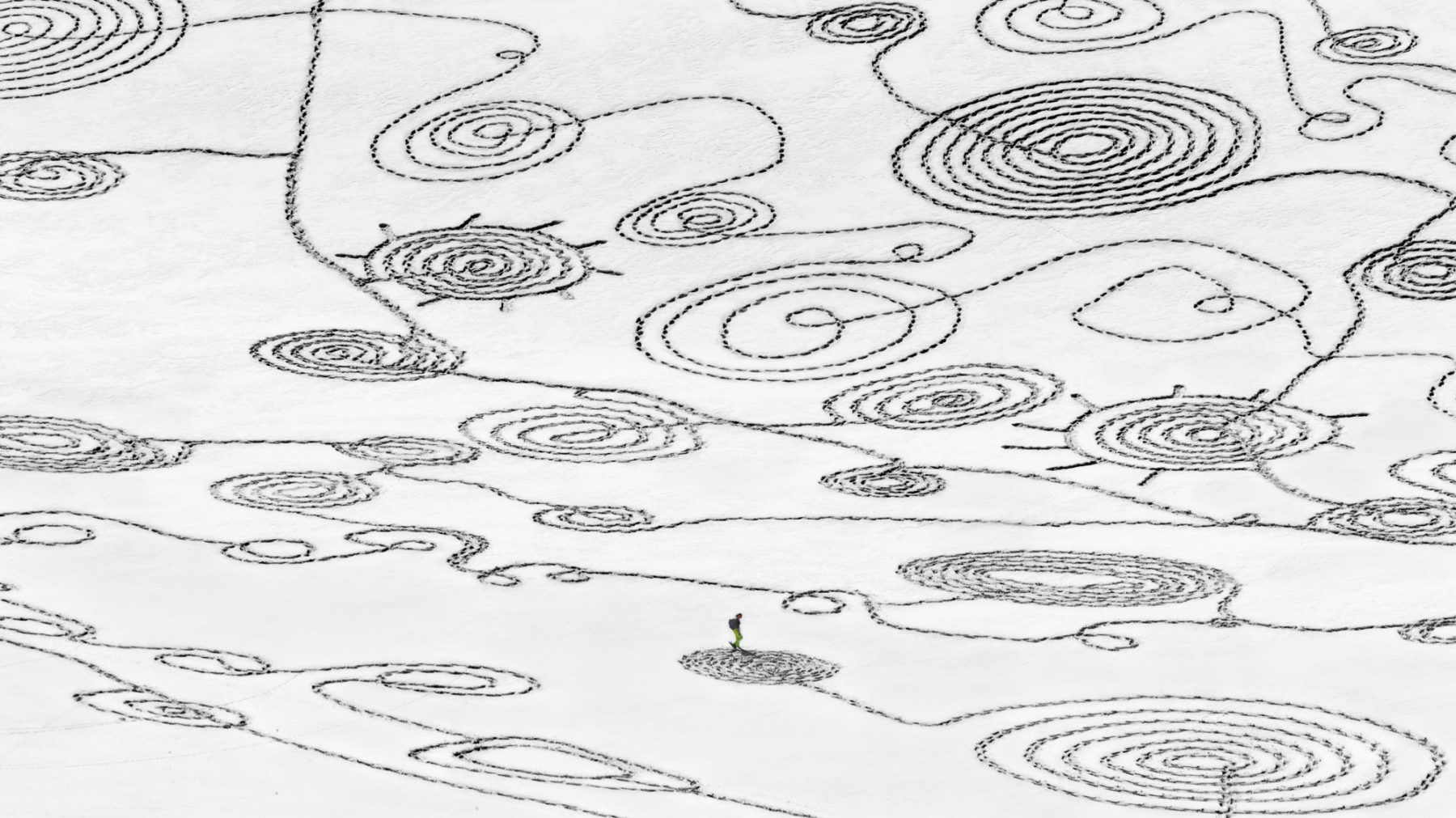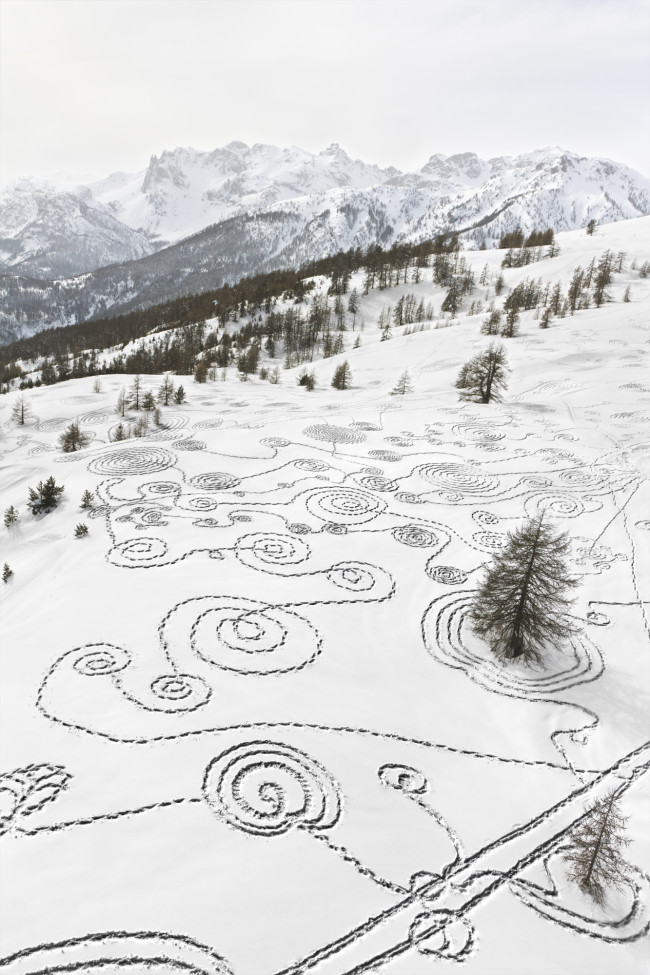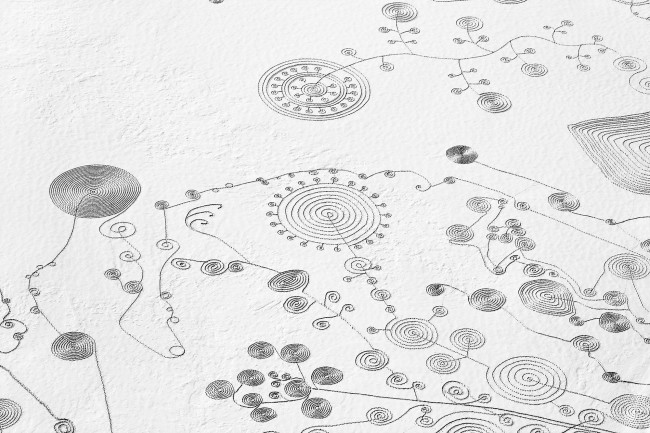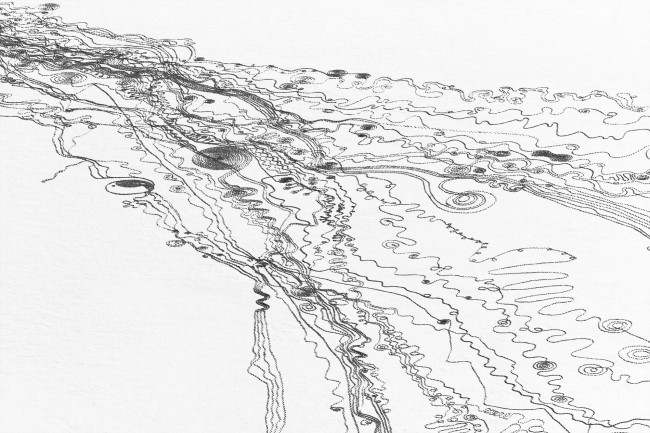Sonja Hinrichsen’s patterns on the snowscape are an ephemeral force on nature. Wearing snowshoes, the environmental artist has spiraled her way over snow-covered mountains and lakes from Colorado and New York, to Finland and France. The results are impermanent bird-footed patterns on the snow. Her installations, made with community volunteers, reveal themselves as intricate drawings from above, while the experience proves more of an immersion in texture and shadow at ground level.
“Snow drawings last such a short time. It could be two to three hours, or two to three days. They define the landscape and they are defined by it,” Hinrichsen said of her work.
Hinrichsen is originally from southwest Germany. She landed in California in 1999 for graduate school at the San Francisco Art Institute. The American West enchanted her and the Bay Area became home base. Her work is ruled by a single thought: “I am nomadic,” she said.
The idea for snow drawings first crept into Hinrichsen’s imagination in 2009 while working at the Anderson Ranch near Aspen, Colo. Soon after, a frozen lake in upstate New York saw some of her winter spirals appear. When Hinrichsen worked in the mountains in France, the ski industry embraced her idea, making sure everyone could ride the lifts to get to her site high on the mountain.
Some of her most enticing work has happened in and around Steamboat Springs, Colo., a historic ski and ranching community in the Rocky Mountains that notoriously accrues dozens of feet of fresh snow each winter. At The Nature Conservancy’s Carpenter Ranch, Hinrichsen’s initial solo installation re-imagined productive haymeadows and rare riparian areas along the Yampa River as a huge canvas. The sense of play that she discovered during long days in the changing light and an awe-inspiring landscape drove her to return to the Yampa Valley to create more art in collaboration with the local community.
Catamount Lake, Steamboat Springs, Colorado.
A Rabbit Ears Pass installation was first – a pair of sprawling snow drawings on an undulating mountainside at the top of the Continental Divide was created by a dozen volunteers over the course of a weekend. The Rabbit Ears snow drawings went viral (including a video created by a local drone operator) and a photograph of it even landed in a calendar of the world’s finest environmental art. A year later, a second Steamboat Springs installation involved more than 40 volunteers working on the flat expanse of Lake Catamount, where participants aimed to “be the drop” and evoke the natural flow of meandering water as they traveled over the frozen lake like a water molecule.
Snow behaves differently depending upon its depth, moisture and texture. It is unpredictable, and this impacts the progress of each design. When she is lucky enough to find a local resident with a small plane or a drone near one of her works, Hinrichsen often captures stunning images of crisp spirals, their contrasting shadows, and glorious winter light. Regardless, the work itself is impermanent – and since the continued creation of snow drawings depends upon snow, changing weather patterns are something to which Hinrichsen pays close attention. The long-term impacts of climate change on this beloved art form are not lost on Hinrichsen.
We are the Water. Yampa River Abstract. Routt County, Colorado.
“This winter has been weird,” Hinrichsen said, summing up her seven weeks on a rocky coastline southern Finland’s archipelago during the winter of 2015. She had envisioned a stunning series of snow drawings along the ocean, but it never worked because the frozen ground didn’t get enough snow. She was able to make use of one snow flurry for a small project – just enough to engage one small community – but “it was so windy that it all blew away. It was a nice experience but not a lot of work came out of it,” she said.
In early March, Hinrichsen traveled to a lake in far northern Finland to seek out a canvas that should have been a sure thing. “They say they would always have snow there. It should have been frozen with snow and a forest around it and a beautiful little church,” she said, conjuring up just how cinematic this series of snow drawings might have been. “But the lake was frozen solid and there was no more snow on it – just bare ice.”
Then she flew to Alaska. “They also had very little snow this year,” she said. “It’s very worrying because the entire western U.S. has had not enough snow, which means not enough water. It’s going to be a problem.” A snowstorm finally enabled Hinrichsen to do a quick installation at Denali National Park with a group of students from a nearby high school. Farther north, in Fairbanks, there was a ton of snow but it was too deep and too cold to work very long, with temperatures looming around at -30 F.
“It was beautiful with the sun but there is a limit to what you can do,” she said. “That was the coldest I’ve ever been in my life.” Within this wild weather year, the snow spirals would have to wait.
See more of Sonja Hinrichen’s snow drawings at sonja-hinrichsen.com.




